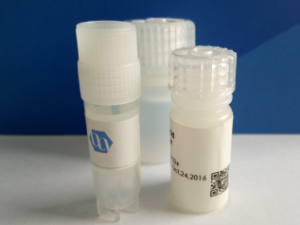$ 660.0
Quantity:1mg
In stock
Description
Product name: Apelin-36
Catalog#: 1431001
Organism: Human
Synonyms: Apelin-36 (human),LVQPRGSRNGPGPWQGGRRKFRRQRPRLSHKGPMPF,
CAS NO.:
Sequence: Leu-Val-Gln-Pro-Arg-Gly-Ser-Arg-Asn-Gly-Pro-Gly-Pro-Trp-Gln-Gly-Gly-Arg-Arg-Lys-Phe-Arg-Arg-Gln-Arg-Pro-Arg-Leu-Ser-His-Lys-Gly-Pro-Met-Pro-Phe
M.W: 4195.9
M.F.: C184H297N69O43S
Purity: 95%
Counter ion: Trifluoacetate
Format: Lyophilized powder
Description: Apelin was originally isolated from bovine stomach tissue extracts. It has been identified as an endogenous ligand of the APJ receptor, a G protein-coupled receptor related to angiotensin receptor AT1 (Lee et al., 2000a). Apelin is derived from a 77-amino acid length precursor peptide that can be cleaved by angiotensin-converting enzyme 2 into active apelins, including apelin-36 (42–77), apelin-17 (61–77), and apelin-13 (65–77; Lee et al., 2000b). Apelin-13 has completely conserved 13 C-terminal amino acids that are cross all species and exhibits the highest biological potency, including cardiomyocytes protection (Hosoya et al., 2000; Kleinz and Davenport, 2005; Simpkin et al., 2007). The active apelins are widely distributed in various organs and tissues, including the brain, lungs, testis, and uterus, and are highly expressed in the cardiovascular system. In the brain, apelins are widely expressed in neuronal cell bodies and fibers throughout the entire neuroaxis (Cheng et al., 2012). In neurological diseases, apelin level is significantly altered in the central nervous system. For example, apelin is significantly elevated in the epileptogenic temporal neocortex and absent in glial cells of temporal lobe epilepsy patients.
Uniprot ID: Q9ULZ1
Usage: For Scientific Research Use Only, Not for Human Use.

